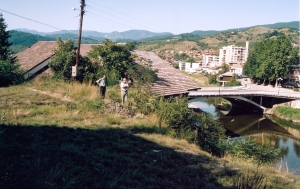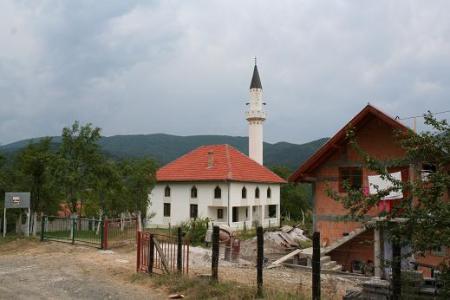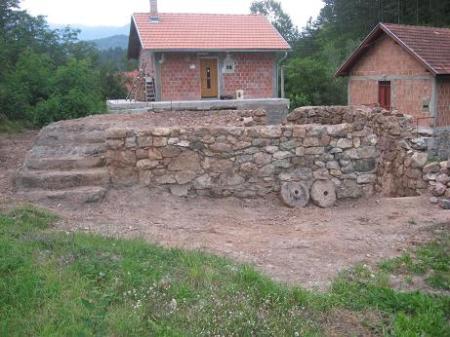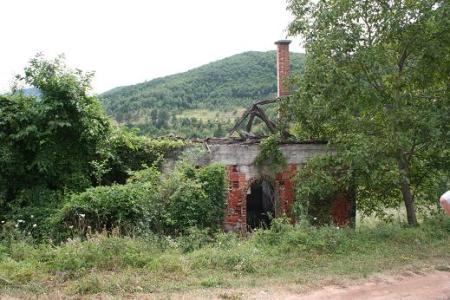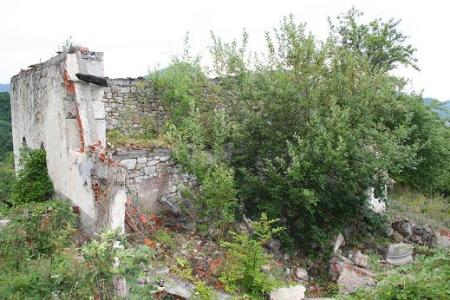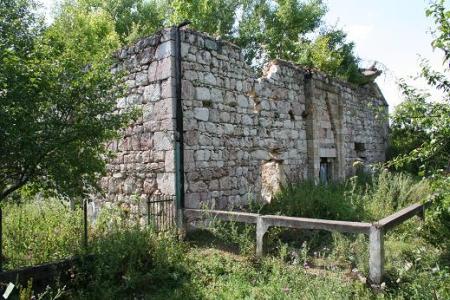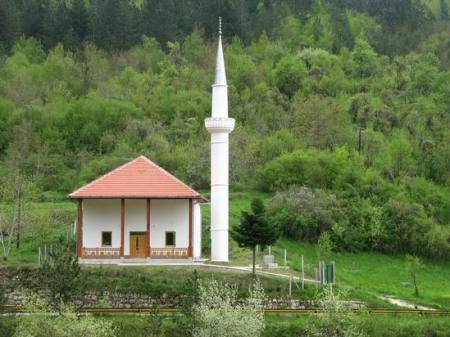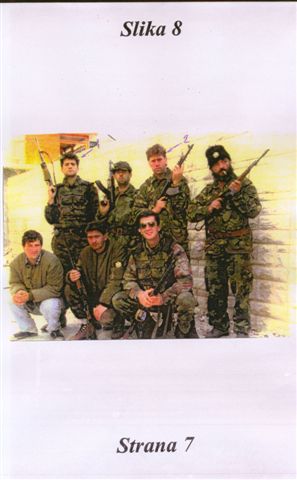Image:Yugoslav Royalist Forces commonly known as Chetniks, slaughtering a civilian in this undated picture.
Bosnian Muslim villages in Visegrad destroyed and cleansed 1941-45: Part I
Gornje and Donje Štitarevo: Around 283 Bosnian Muslims were massacred by local Serbs, members of Yugoslav Royalist Forces(Chetniks) in World War Two. The following families were completely cleansed from the village: Arnauti, Pite, Ferhatovići, Musić,Gaka etc. For crimes committed in this village,thanks to a survivor Nurko Cocalić, three local Serbs were prosecuted by a Court in Sarajevo: Dušan Vasiljević, Milomir Gogić and Zdravko Popović.
Rujište: Local Serbs massacred around 65 Bosnian Muslim neighbours including 22 women and children. The main perpetrators were Petar and Milorad Lukić. Entire Muslim families were cleansed from Rujište: Čavkušić, Liske and Smajlović.
Menzilovići: Local Serbs massacred around 21 Bosnian Muslim neighbours in March 1942. Several Muslim women were raped including a pregnant women Hata Menzilović. The main perpetrators were: Milan Glišić, Rade and Milan Lindo, Blagoje Sapoljnić, Đoko and Ilija Marković, Miroslav Kargan and Zorka Papić.
Stari Brod: Local Serbs and members of Milan Nedić’s Army at the beggining of 1943, gathered surviving Bosnian Muslims civilians, most of whom were women and children, from surrounding villages: Gornje Štitarevo,Vlahovići,Pozderčići, Kapetanovići, Sendići, Prelovo, Omeragići, Presjek, Gostilja etc. These civilians were brought to Stari Brod village where they were barricaded in a house and two stables and burnt alive. A Bosnian Serb Jovan Gogić from the village Blace, admitted that he witnessed this crime.
Omeragići: Around 42 Bosnian Muslims were massacered by their Serb negibours and members of Yugoslav Royalist Forces(Chetniks) in World War Two. One group of Bosnian Muslim men were excecuted in a forest called ”Duboko” and ”Hrtar”. Another group was excecuted in Zvekara cave. Some women and children were burnt alive in live pyres in Stari Brod.
Image: Ćamka Murtić(village Gostilja) and Safa Halilović(village Sase), raped and slaugthered by Bosnian Serbs from Visegrad, 1941. Picture taken by Sejdo Grabovic.
Kurtalići: Around 21 Bosnian Muslims were massacred by Serb neighbours and members of Yugoslav Royalist Forces(Chetniks) in World War Two.The main perpetrator of his crime was Đoko Marković. Both witnesses of this masscare, Nurif and Mehmed kurtalić, were murdered in Kurtalići in 1992 by Bosnian Serbs.
Mušići: Around 60 Bosnian Muslims were massacred by Serb neighbours and members of Yugoslav Royalist Forces(Chetniks) in World War Two.The perpetrators of this crime included: Lazar Đurić, Stjepan Dikić, Ilija Marković, Luka Đurić and a women Zorka Papić. Ćamila Bosno, a Bosnian Muslim, witnessed when Zorka Papić beat to death her Muslim neigbhour Halima, who is Ćamila’s aunt.
Pozderčići: Around 39 Bosnian Muslims were massacred by Serb neighbours and members of Yugoslav Royalist Forces(Chetniks) in World War Two. Their property was looted by neigbouring Serbs. The main perpetrator of this crime was Ratko Mitrašinović who led a group of Chetniks from neighbouring Serb villahe Kragujevac. The remaining Bosnian Muslim civilians – women and children, sho survived this crime were later taken to Stari Brod where all were burnt alive in live pyres.
Kupusovići: Around 61 Bosnian Muslims were massacred by Serb neighbours and members of Yugoslav Royalist Forces(Chetniks) in World War Two. The main perpetraors were : the Mitrašinović brothers and Miloš Miličević. Aleksa Vojinović from Serb village Blace, kidnapped Hasna Kupus whom he raped and then murdered. The mosque in Kupusovići was completely destroyed and its stone was used in the construction of a church in Blace.
Koritnik: Around 47 Bosnian Muslims were massacred by Serb neighbours and members of Yugoslav Royalist Forces(Chetniks) in World War Two. Yugosla historian Vladimir Dedijer in his book ”Crimes against Muslims 1941-1945”, documented the testimony of one survivor Mehmed Kurspahic who witness the horrific torture of Mehmed Spahic.
Image: The Mehmed-pasa Sokolovic Bridge, blown up by German Nazi troops.
Žlijeb: Around 109 Bosnian Muslims were massacred by Serb neighbours and members of Yugoslav Royalist Forces(Chetniks) in World War Two. During the first attack in November 1941, most of the village’s populaion fled to Višegrad, but later returned due to garantees from Serbs and most importantly from the Italian Fascist army command in Višegrad. Almost all men who returned to Žlijeb were massacred. The village was left wih 33 widows,100 orphans and almost 15 families were left without a single member. The perpetrators of this crimes were: the Mitranović brothers from Kragujevac village, Ilija Mitrašinović, Miloš Miličević, Petronije Knežević, Sredoje Knežević-Ivankić, the Radovanović brothers from Odžak village,Radoje Novaković from Odžak village etc.
Klasnik: Around 171 Bosnian Muslims were massacred by Serb neighbours and members of Yugoslav Royalist Forces(Chetniks) in World War Two. During the first attack in November 1941, around 26 men were massacred, most of the village’s populaion fled to Višegrad, but later returned due to garantees from Serbs and most importantly from the Italian Fascist army command in Višegrad. Bosnian Muslims were called to the Chetnik HQ to report and receive a security not for safe passage through their controlled area. Around 29 men went to report and never returned. Since most of the families were left without their menfolk, there was no one to protect them. The Chetniks used this situation for a raping spree. Dozens of Muslim women in Žlijeb village were raped.
Kapetanovići: Around 55 Bosnian Muslims were massacred by Serb neighbours and members of Yugoslav Royalist Forces(Chetniks) in World War Two. In March 1942, Rade, Sredoje Novaković and Vitomir Krstić from Pozderčići and Milija Radovanović from Odžak gathered around 18 Bosnian Muslim men to take them to the Chetnik command in Odžak to receive a security not for safe passage through their controlled area. After a failed escape attempt, the remaining men were taken to Mount Rogopek and excecuted. Thanks to Nusret Kapetanović, a orphan from Kapetanovići, Rade and Sredoje Novaković and Vitomir Krstić were arrested and sentenced to 20 years prison.
Resnik: Around 102 Bosnian Muslims were massacred by Serb neighbours and members of Yugoslav Royalist Forces(Chetniks) in World War Two. According to witness accounts, several Muslim girls and women were raped.
Kamenica: Around 112 Bosnian Muslims were massacred by Serb neighbours and members of Yugoslav Royalist Forces(Chetniks) in World War Two. The main perpetrators of this crime were : the Gudović brothers, the Vujkić brothers and Lazo Stjepanović from Paočića village. In a live pyre in the house of Bećo Bosno, around 26 women and children were burnt alive. Two Bosnian Serb neighbours Petar Lukić and Božo Ivanović raped Muslim women Šehrija Pjevo and Šefku Dudević. Several Serbs were reported to Police authorities after the war but no action against them was taken.
Mala Gostilja: Around 43 Bosnian Muslims were massacred by Serb neighbours and members of Yugoslav Royalist Forces(Chetniks) in World War Two. It should be noted that a Serb women Radina Andrić, wife of Ratko Andrć warned Muslims from this village that the Serbs were planning to massacre Muslim men and thus saved a large number of men.
Image: Brigadier Charles Armstrong with Yugoslav Royalist Army General Draze Mihailovic, responsible for genocide against Bosnian Muslims in Eastern Bosnia, near Visegrad 1943 . Mihailovic overlooked the attack on Visegrad and the slaughter of around 3,000 Bosnian Muslims in and around Visegrad. A number of British and American intelligence officers were present during the occupation of Visegrad and witnessed the massacre of Bosnian Muslim civilians.
Source: Krvava Ćuprija na Drini, Mustafa Sućeska, DES, 2001. Mr. Sućeska is a World War Two Visegrad Genocide survivor.




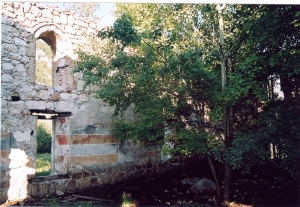

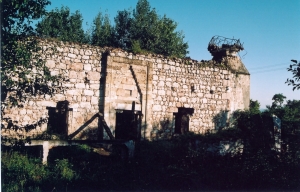

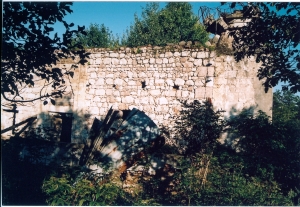
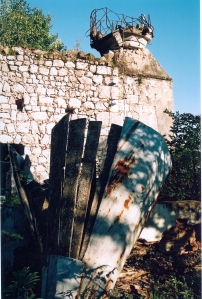

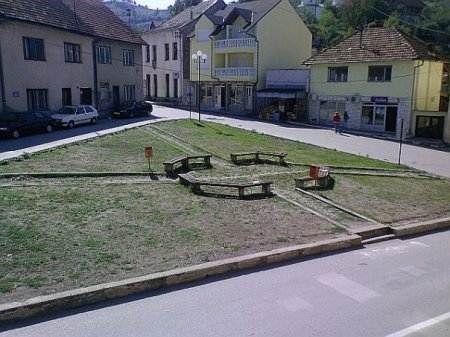
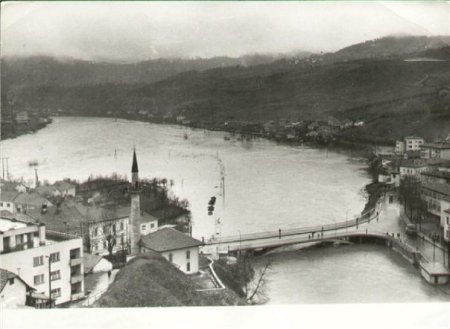

 Image: The Emperor’s Mosque set ablaze by Bosnian Serb Army in Visegrad, June 1992.
Image: The Emperor’s Mosque set ablaze by Bosnian Serb Army in Visegrad, June 1992.